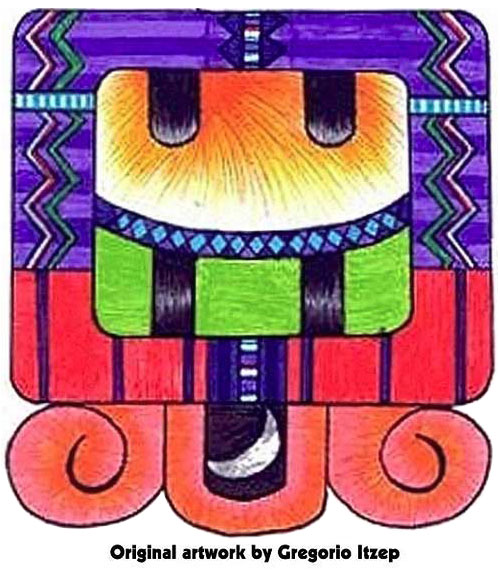
Ben Trecena
by Kenneth Johnson
This day sign is variously known as Reed or Cane but symbolically related to Corn. There was an Aztec prophecy to the effect that the god-king Feathered Serpent or Quetzalcoatl would return to humanity in the year they called 1 Reed. The year 1 Reed corresponded to the year 1519 in the Gregorian Calendar, and it was in that year that Cortez arrived in Mexico. The emperor Montezuma suspected that Cortez’s advent represented the fulfillment of the old prophecy, and this apprehension on the part of the Aztec emperor played a major role in the fall of ancient Mexico.
Quetzalcoatl was one of the most ancient of the gods of Mexico, and his image decorates many of the temples of Teotihuacán which flourished from the beginning of the Christian era until about A.D. 700. He is best known, however, as a great priest-king of the Toltecs. As ruler of the Tolteccity of Tula he declared an end to human sacrifice. Instead he demanded that the gods should be worshipped with sacrifices of flowers, song, and meditation. The priests of Tezcatlipoca, god of the Smoking Mirror, stood against him. They “showed him his face in the mirror” —which is to say, they awakened within him the dark side or Shadow, that primal force that Tezcatlipoca symbolizes and which is perceived within us only when we gaze into his mirror of the self. Finally these priests lured Quetzalcoatl into incest with his sister. Fallen and disgraced, the prophet left his people and journeyed to the Gulf Coast. What happened to him there is unclear. According to one version of the story, he cast himself onto a funeral pyre and rose again as the Morning Star, the planet Venus.
It is said that Quetzalcoatl erected a pillar in the city of Tula, the “Place of Reeds.” This pillar is a kind of World Tree, a cosmic center. In Momostenango, the village leaders carried a staff of office, and I was told that this day sign was symbolically linked with those staffs, emblems of authority. Thus, the growing Corn may be regarded as another metaphor for the central pillar or universal World Tree, source of all inner power and authority.
The stalk of corn that grows tall and with so much authority at the center of the world is to be found in the Popol Vuh or Mayan Creation Epic as well. When the Hero Twins, Junajpu and Xb’alanke, are about to journey into the Underworld to challenge the Lords of Death in a game of handball, they plant a stalk of corn in their grandmother’s hearth. They tell her that if the corn withers, it means they are dead, but if it sprouts again, they are once more alive.
The corn withers when the Hero Twins die, but then returns to life, as do the Twins, having traveled the paths of the Underworld and conquered death.
This day sign is the inner voice and the spiritual intent of our First Grandmother, when she prayed for a sign that her grandsons had survived their trials in the Underworld. In fact, the K’iche’ word itself, Aj (pronounced “ah” with a very slight guttural “k” sound at the end), appears in this passage of the book and ipart of a language pun intended to draw the reader’s attention to the fact that the creation epic is discussing the metaphysical meaning of this daysign.
This is a day-sign of strength, of resurrection, of the triumph of life over death. It is the inner process that causes all things to return, again and again, in an endless cycle of life never-ending. The vital power at the center of all things, it is symbolized in the human body by the spinal column which forms a channel for that same vital force, the force of life itself.
My teachers always used the Spanish word hogar as a key term to describe this day sign, and hogar means “the hearth,” not just in its physical but in its metaphorical sense. Because the Hero Twins planted corn in First Grandmother’s hearth, and the hearth is the center of the home, this day is therefore the nagual of the home, and especially of the children within it, for our children are none other than ourselves reborn; they are living symbols of our power to regenerate and renew ourselves, for they are created from our own vital energy, which they carry with them into the future, into eternity.
This is a time to give thanks for the place in which we live; this trecena connects us to the nourishment and flourishing of all things related to the home, whether human, animal or plant. It symbolizes the energy and vitality of life itself. It strengthens the family system and lends vital energy and power to all matters within one’s household.
http://www.jaguarwisdom.org

